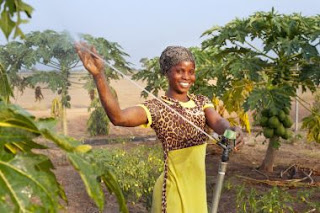In today's blog post, I will be looking at the link between groundwater, water scarcity and gender to contextualise the inequalities in the access and use of this water resource. I will be focusing on these inequities in relation to the use of groundwater by using Ethiopia, Ghana and Zambia as case studies. But first, let's have a look at how we define water scarcity...
Water Scarcity
In the broadest sense, physical water scarcity can be defined as the ‘shortage in the availability of renewable freshwater relative to demand’ (Damkjaer and Taylor 2017). However, it is important to remember that economic water scarcity often plays an integral part in gender disparities too; this refers to the lack of appropriate infrastructure and a limited institutional capacity to ensure a reliable water supply (Rosa et al, 2020). Physically, Africa's arid climate makes its countries particularly vulnerable to significant changes in climate, through effects such as the El Nino Southern Oscillation (ENSO) (Gizaw and Gan, 2016). Coupled with the effects of climate intensification such as variability in rainfall and an increased frequency of droughts, the physical risk of water scarcity increases (UN, 2018).
Defining water scarcity also requires the use of a quantitative metric, such as the Water Stress Index (WSI) or the Water to Availability (WTA) index (Fallenmark, 1989; Damkjaer and Taylor, 2017). However, these indices use mean annual river runoff (MARR) to determine water scarcity which masks the intra- and inter-annual variability in freshwater resources (Damkjaer and Taylor 2017); this is especially important considering the projected increase in the frequency of El Nino events in tandem with climate change (Gizaw and Gan, 2016). To add to this, these indices do not account for green water (soil water) or groundwater. Green water is integral for determining the water demand of food production, especially in Sub-Saharan Africa and it has been estimated that between one third and one half a billion people in Sub-Saharan Africa rely on groundwater for their daily water uses (Carter and Parker, 2009). Considering the importance of these water sources, these indices are perhaps not best for determining water scarcity in Sub-Saharan Africa.
 |
| Figure 2: Water scarcity defined by WTA |
Groundwater and its Unequal Access
Groundwater has the potential to serve as a reliable water source, especially during dry seasons to reduce the dependence on increasingly seasonal rainfall (Villholth, 2013). However, the unequal access that women have to groundwater in comparison to men is hindering this potential.
In the Ethiopian case study, women are keen to use groundwater and are concerned with its sustainability, however, there is a disparity between the male and female participation (Nigussie et al, 2018). The lack of women in management and decision-making roles, such as those in water user associations (WUAS), limits the communication of the needs from women who wish to get more involved with groundwater (Nigussie et al, 2018). There were many reasons why women felt like they could not participate in groundwater management, such as: illiteracy, a heavy domestic workload and the fear of gender-based violence (we will look into this later on in another post!) (Nigussie et al, 2018). Considering the different needs that women will have to men in terms of groundwater use, this is certainly an issue which is overlooked.
In the Ghana and Zambia case studies, we see a similar issue; women are eager to make use of groundwater irrigation, however, this has been hindered by their substandard access to technology and land (Van Koppen et al, 2013). Women have less access to the required technologies for groundwater withdrawal because of the dominance of men in these technological industries (Van Koppen et al, 2013). This has created a disparity in the access of technologies for men and women; whilst male-headed households were more likely to adopt mechanised motor pumps, female-headed households were more likely to use labour-intensive methods such as buckets (Van Koppen et al, 2013). The use of more advanced technologies, such as motor pumps, has been shown to not only improve ease of extraction but to also improve incomes compared to other forms of irrigation (Colenbrander and Van Koppen, 2013). Women are further disadvantaged in terms of their use of groundwater irrigation by the lack of their land rights. As women's use of land is primarily controlled by men in male-headed households within Zambia, the adoption of groundwater irrigation becomes harder to achieve (Van Koppen et al, 2013).
What can we take from this?
These case studies illustrate how women's use and access of groundwater is limited by a range of factors, from their lack of management roles to the disparities in their access to technologies and land. These obstacles will continue to hinder gender equality in groundwater use, unless initiatives are taken to encourage women to participate in groundwater management so that issues such as societal norms and illiteracy can be addressed on a wider scale (Nigussie et al, 2018). Achieving extensive gender equality could help address issues in relation to water scarcity through the greater use and access of groundwater resources. If we are to achieve such development goals, a greater awareness needs to be spread in these countries of how gender equality can influence agricultural growth (Van Koppen et al, 2013).


Comments
Post a Comment